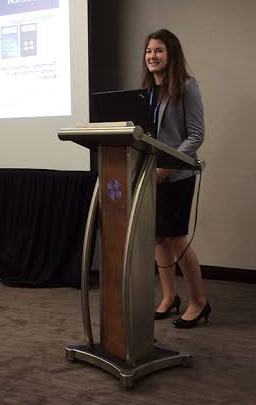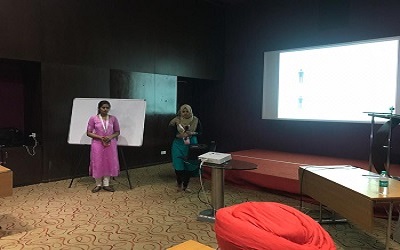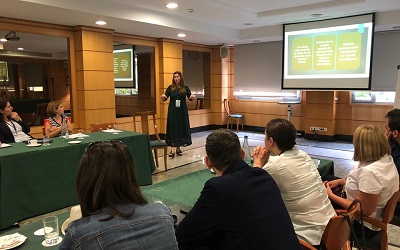What is an Oral Presentation ?
As an oral presenter, you can deliver your presentation live to an audience effectively and engage in fruitful discussions with the audience. The registration fee packages(Registration Link) present many benefits to oral presenters.
Guidelines For Presentation
Consider the sequence and relevancy of your slides. A current slide should build a path to next slide.
Use graphs and charts to illustrate your prominent points. They will help the audience to clearly understand the content.
Make it simple. Too much fancy graphs and charts with huge data and numbers will confuse the audience. Don’t use flash, gif images and fancy colors. The audience will only remember those effects, not your message. Make it simple!
Use the 6-6-6 rule: (maximum 6 words per bullet, maximum 6 bullets per slide, and maximum 6 text slides in a row). The fewest words with effective imagery will have the most powerful effect.
Use high-contrast, easy-to-read fonts that are common to most computers. Do not use ALL CAPS, italics, and other enhancements that clutter and distract. A good guideline is a minimum of 30-point font.
Presenting Effectively
Please follow the guidelines below to make your presentation effective. The tips below will help you to keep the audience interested throughout your presentation.
Form a story: Try to tell a story rather than give too much of information. Organize your thoughts, develop a good transitions between slides.
Use visual aids: Visual aids such as slides attract and hold an audience’s attention and help to reinforce what you say as well as help you keep on track with your presentation. You need to keep things visuals – and your remarks – simple and easy to read and understand.
Kick off start: Start the presentation with some eye-opening facts from your findings. One good way to get the audience’s attention is to start with a question.
Make the case relevant to the audience: Make your points in presenting your findings to the audience. The more relevant your presentation is to the audience the more interested they will be.
Reduce your introduction: The session chair will introduce you and save time for important points.
Never read from your slides: Your audience will be reading your slides. Support them with more clarifications.
Practice speaking: Practice as much as possible and consider the time you are given. You will only have 15 – 20 min. use it wisely, fully and effectively. The more you practice, the more comfortable you will be.
Avoid jargon: Using more specific words may reduce the audience’s interest. Especially when speaking about your institute’s/company’s processes.
Give priority to your findings: Give priority to your findings and outcomes. Reduce the time that you spend on background.

What is a poster presentation ?
As a poster presenter you can deliver your presentation effectively to an audience in the form of a poster.There is no formal oral presentation in a poster session, instead each author is assigned a display area on which diagrams, graphics, data, pictures/photos, and a small amount of text are presented.
How you should make the content of a poster ? A good poster should answer following questions.
Does the poster deliver a message ?
Is the information not enough or too much ?
Do the graphics express the information ?
Is the presentation original in its content or findings ?
Is the methodology mentioned ?
Are the aims and objectives mentioned ?
Are the conclusions/results presented ?
Visual Guideline For Poster
Poster Size
Dimensions for the posters are 2*3 feet (Width 2 and Height 3). Please ensure that your poster does not exceed this size.
Poster Submission
Please ensure that you handover the poster to the organizing committee at the registration table.
Poster Viewing Session & Evaluation
A time slot will be allocated for the poster viewing in the conference program and please ensure that you stand by your poster(s) for discussions and questions during that session.
Poster presenters are able to explain their material, answer questions, exchange contact information, and fully discuss the subject matter, as visitors examine the displays during the time allocated for poster presentation.
If you are unable to attend the conference in person mainly due to financial or any other reasons, but still wish to have your paper presented and published, we offer virtual presentations for your convenience. There are two types of virtual presentations available.
HOW TO BE A LIVE VIDEO PRESENTER ?

Requirements
Laptop with headset/ Desktop with Webcam and Microphone/headset.
Updated Chrome Browser.
Virus Protections are needed to be paused/disabled before the start, if not will block the webcam.
Bright and calm environment with a professional background.
You are required to submit a proposal/Abstract which will undergo a double-blind peer reviewing process for the Abstract Acceptance. Upon the confirmation to the Conference, a test run will be conducted by the organizing committee in close proximity to the Conference. The participant will be given guidelines on how to connect during the Conference and present. After the Presentation and Conference Conclusion, you will receive a copy of the Conference program, Certificate of Presentation, Book of Abstracts and TIIKM branded stationaries along with the Conference Pack.
POWERPOINT VIRTUAL PRESENTATION

Requirements
To be a virtual presenter under the PowerPoint virtual presentation category, you only need to send us your PowerPoint presentation (with video and/or audio embedded to the presentation). Your presentation will be uploaded in the conference website.
Please note that the same publication opportunities that are available regular presenters will also be available to you. You are still required to submit a proposal/abstract, and one author must pay the registration fee. About 2 – 3 weeks after the conference, you will receive a certificate of presentation, the Book of Abstracts and TIIKM stationary, along with the conference bag.
Abstracts will be published in the Abstract Book.
An opportunity to publish in conference proceedings.
Conference materials including the author certificate as a virtual presenter, book of abstract(hard copy), conference program book(hard copy),note book and pen will be posted to every virtual presenter after the conference.